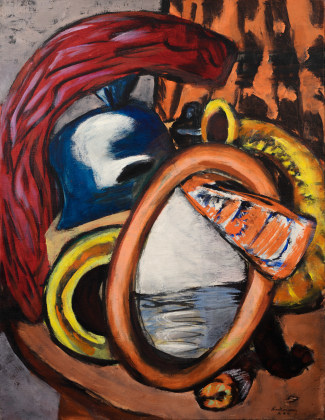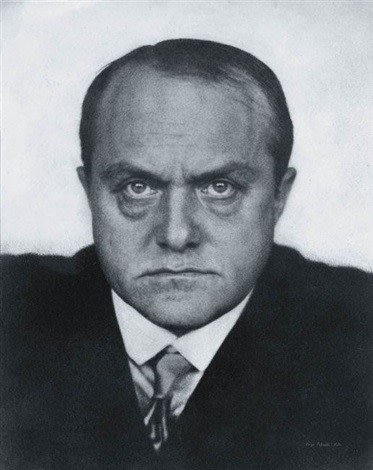
Max Beckmann (1884–1950)
Stillleben mit Helm und rotem Pferdeschwanz, 1943
(Still-Life with Helmet and Red Horse's Tail)
Oil on canvas
33 1/2 x 25 3/4 in. (85 x 65.5 cm)
Signed and dated lower right: Beckmann A.44
Painted in Amsterdam in 1943-44
Max Beckmann saw great spiritual significance in his art. As he wrote in 1920, in an essay titled “Creative Credo,” making art “is the only course of action that might give some purpose to our superfluous and selfish existence—that we give people a picture of their fate.” He believed that it was his duty to make art that was a realistic reflection of and relevant to the times, a conviction strengthened by his experience in the medical corps of the German army during WWI. What resulted were paintings, drawings, and prints of unflinching intensity and psychological depth.

Portrait of Max Beckmann, 1928
Photo: Hugo Erfurth
1884
Max Beckmann is born on February 12 in Leipzig, Germany.
1894
His father dies.
1899
Enrolls at the Grossherzoglioche Kunstschule, Weimar where he studies with Carl Frithjof Smith.
1903-04
Travels to Paris, Geneva and Florence. Begins his lifelong habit of keeping a diary.
1904
Moves to Berlin.
1906
Marries fellow art student Minna Tube.
1912
Beckmann’s first solo exhibitions are held at the Kunstverein, Magdeburg and the Grossherzogliches Museum für Kunst und Kunstgewerbe, Weimar.
1914
Following the outbreak of the First World War, Beckmann volunteers for the army medical corps.
1915
Discharged from the medical corps following a mental breakdown. Settles in Frankfurt.
1914-1923
Printmaking becomes his primary focus. Beckmann will eventually produce 373 prints.
1920s
Switches from biblical subjects to subject matter associated with the artists of the Neue Sachlichkeit including contemporary allegories and realistic portraits.
mid-1920s
His work begins to include more Expressionistic brushwork and brighter colors. At the same time his compositions become less crowded and more naturalistic.
1925
Exhibits with the Neue Sachlichkeit at the Städtisches Kunsthalle, Mannheim but never formally joins the group. He is appointed as a professor at the Städliches Kunstinstitut, Frankfurt.
1926
The first exhibition of Beckmann’s work is held at J. B. Neumann’s New Art Circle in New York.
1928
A large retrospective of his work is held at the Städtisches Kunsthalle, Mannheim.
1929-1932
Continues teaching in Frankfurt but spends his winters in Paris. Begins using the triptych format.
1933
Following the rise of the Nazis in Germany he is dismissed from his teaching position in Frankfurt and moves to Berlin.
1937
More than 500 works by Beckmann are confiscated from public collections. His work is included in an exhibition of “degenerate art”. One day after the exhibition opens, Beckmann flees Germany for Amsterdam where he will stay for the next ten years.
1938
Curt Valentin’s Buchholz Gallery, New York holds an exhibition of his work.
1947
Travels to Paris and the south of France. Begins teaching at the School of Fine Arts at Washington University, St. Louis.
1948
His first U.S. retrospective is held at the City Art Museum, St. Louis.
1949
Teaches the University of Boulder, Colorado during the summer and at the Brooklyn Museum Art School in the fall. Awarded first prize in the Painting in the United States exhibition at the Carnegie Institute, Pittsburgh.
1950
Dies on December 27 in New York at the age of 66.